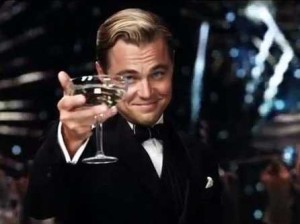
I couldn’t resist the costumes and pomp the trailers promised. So myself and a group of women of a certain age gathered to view the newest incarnation of the novel, The Great Gatsby. I wrote about my trepidation regarding this version when viewing the coming attractions. I saw how gaudy and overblown the production values seem to be, and had that sinking feeling, oh good lord, it’s going to be another Moulin Rogue. Baz Luhrmann directed both, and the outrageous sets, computer graphics, and effects are similar, but with Gatsby, they’re on steroids. All sorts of factual mistakes are made, from the year and make and model of Gatsby’s and other
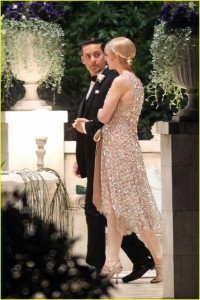
cars, to various fake luminaries at his extravagant parties. Parties that no human could possibly provide, even in the robber baron days of Carnegie and Rockefeller. The fake estates looked faker than usual, and they belonged in Newport Rhode Island, not Long Island. I realize there are very wealthy people on the Island, but please, the ridiculous excess of statue like waiters, standing at attention for every whimsical move their lord and master made, is almost appalling in the distaste it generates in the audience. And perhaps it would have worked if only Daisy and Tom Buchanan were guilty of this practice. But Gatsby also had black, white, whatever, menial employees at his beck and call. I suppose this was Luhrmann’s point—the excesses of the rich during those years was over the top. But his version of over the top took the book from a realistic novel about selfish privileged people and a man whose greatest desire was to become one of them, and turned it into a cartoon of grand proportion.
Not to say the film wasn’t entertaining. It was that. But what it wasn’t was a good reflection of what F. Scott Fitzgerald wrote. Even Fitzgerald, an alcoholic himself, would not have taken the society he saw around him and inflated it to this degree. The staggering amount of party goers attending each time could have filled a couple of football fields, and the thinly disguised musicians unlikely in my opinion to exist in that form–endlessly performing for? Were they paid? The film doesn’t make that clear, for all the audience knows, and it’s implied, these performers and dancers were party goers having a magnificent time boozing it up with the others. There was an undeniable Cab Calloway lookalike at the center of the parties–too bad this takes place in 1922, and Calloway was around 15 and just taking voice lessons.
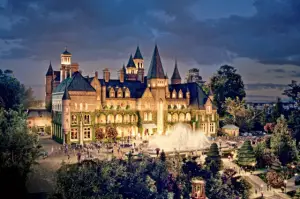
I don’t think I need to remark upon the unbelievable choice to include rap music, or excuse me, hip hop music, to a film set in the richly filled jazz years. Any number of superb jazz performers and their recordings would have made the statement needed without jarring the movie goer out of that period into the here and now. I’m guessing, again, the director felt this was the way to draw in ‘youth’. And from the box office reports, I’m betting it did the job. But did it make it a better film? An excellent representation of the novel? I guess I did remark upon this absurdity, after all. An interesting tweet “Mystery Science Theater 3000” star Frank Coniff: “Baz Luhrmann says Fitzgerald would have wanted a 3-D Gatsby with rap music. Agreed — he was an alcoholic with poor judgement.”
I noticed a particular point of political correctness during a car race over of all things, the Queensboro Bridge going into Manhattan. A car alongside the two driven by
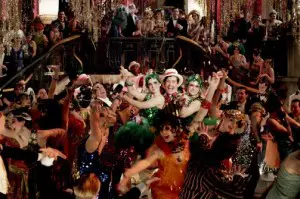
Gatsby and Buchanan had a white chauffeur while a black man and women drank and caroused in the back. I never understand why there is a necessity to try to amend or rewrite history. Not that a rich African American couldn’t have existed and had a white chauffeur, but why when you are telling a certain story about a certain time and place, is it necessary to try to balance the racial or ethnic lines? If a film adaptation of a classic African-American story threw in a scene such as that, would that be considered balancing out the tale? I despise the attempts to rewrite novels, films, plays to reflect modern sensibilities. Show us as we really were. How the upper classes demeaned and used the underclass filled with Irish indentured servants, black housemaids working for a pittance, etc. How can we ever understand the present situation if we can’t show how we got here? This may be a small point within the film for most, and it probably isn’t worth much, but it irked me.
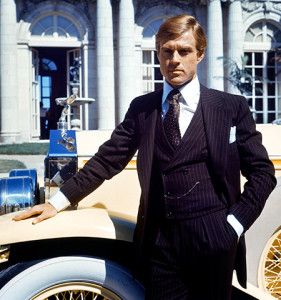
The film used a device of the narrator, Nick Carraway, telling his story from an asylum. Shabby and silly. As if the audience would be too stupid to understand the telling of a story without grounding his voice within a setting. And oh god, the film was for some viewers, in 3D. And, could you tell, even if not watching it that way. Daisy spends countless moments throwing Gatsby’s beautiful shirts over a balcony-Ding!!–Must have looked FABULOUS in 3D! I lost count how many times the green light at the end of Daisy’s dock was shown, mistily. I’m sure the 3D added to Gatsby’s deep longing for her and that life. The billboard with the Eye Doctor seeing all, must have leaped out at the viewer, and, well, the mistress’ demise probably was quite a hit, uh, with the audience. 3D within this film is adding insult to injury.
In terms of acting, I don’t know how to gauge it. The surroundings were so overwhelming, the characters seemed small. I liked Leonardo, but never pictured Gatsby that
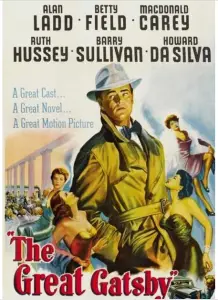
insecure–yes, he longed for Daisy, but was he such a nervous wreck? Maybe I missed something. I hated Daisy as much as usual. Loved her gowns and jewelry, naturally.
Actually, if all one wanted from this film was a pretty fake Deco period filled with extravagant baubles and unlikely gowns, then the film was a fantastic success. If you went to see a realistic rendition of a classic novel of loss, then you’d be disappointed. Not that I think the other versions were much better. Alan Ladd, although my mother’s favorite movie star, would not be my vision of Gatsby. Robert Redford was much better, and the extravagance toned down, but it looked like the 1970s, of which it was made, at least this one stayed truer to the period even if too too perfect, or ridiculously bizarre, as the computer graphics depicting the area of poverty was. Still. I felt badly for delusional Gatsby laid to rest in his beautiful suit. And the final words of the book t remained- poignant-and understated. Calling Daisy and her ilk, ‘careless people’ underlines just how despicable they really were, and how pathetic Gatsby and we who aspire to be like the Buchanans are.
